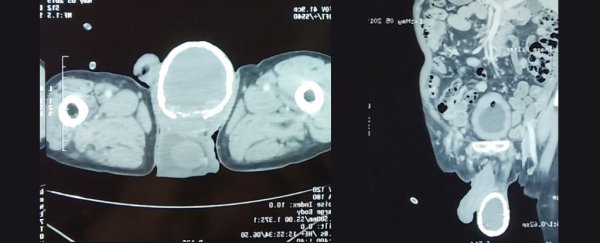Doctors in India recently encountered a truly delicate situation when an 80-year-old man came in with blood in his urine and symptoms of a lower urinary tract infection. But his problem turned out to be quite beyond a simple UTI.
A quick examination of the patient's swollen scrotum revealed that one of his testes was stony hard to the touch. With this finding, the urologists at King George's Medical University in Lucknow suddenly had a rare medical case in their hands.
A CT scan revealed the man's right testicle was swimming in fluid – what is referred to in medical parlance as a hydrocele. Only this one had a rather unusual complication. The sac of liquid had developed a thick, eggshell-like layer of calcium.
Calcification isn't an uncommon clinical affliction in itself. Our blood carries calcium from our bones around our bodies to perform a variety of tasks, occasionally depositing it in soft tissues as a 'stone' (think kidney stones, for example) or even along our blood vessels as plaque.
Inflammation can be a trigger, turning our bodies into weird oysters as tiny stray objects – such as a lodged seed, an impacted tooth, or a bag of drugs smuggled in the nasal cavity – are transformed into the most disturbing kinds of pearls.
In this specific instance, the trauma that kicked off the process was due to an accumulation of fluid trapped beneath the membrane surrounding the testicles.
Hydroceles like these are relatively common, typically popping up briefly in newborns before resolving on their own.
Exactly what prevents the body from absorbing the fluid in the first place isn't always obvious. In older folks (especially in hot, tropical climates) the build-up of liquid can be a sign of blockage caused by a parasitic infection.
Given the fact their patient lives in India, the medical team hypothesised that the man's engorged testicle was most likely the result of a tiny filarial worm, such as Wuchereria bancrofti.
These mosquito-borne nasties are often responsible for plugging up the lymphatic system, causing a swelling of body parts characteristic of the disease elephantiasis.
While calcifications and hydroceles aren't all that noteworthy by themselves, they're not often seen together. With years of repeated swelling causing the membrane to thicken around the testicle, layers of calcium can build up gradually over time, transforming the sperm factory into a hard-shelled egg.
The urologists behind this case study note that the first such occurrence was mentioned back in 1935. Since then, just a handful of similar cases have been reported.
While the infection itself can be treated with antifilarial drugs, the doctors note that treatment for the affected testicle typically has to involve surgery.
The team used their attention-grabbing medical case to recommend annual treatment with antifilarial drugs for people who live in areas with a high risk of these infections. Sounds like a good plan to us.
This report was published in BMJ Case Studies.
